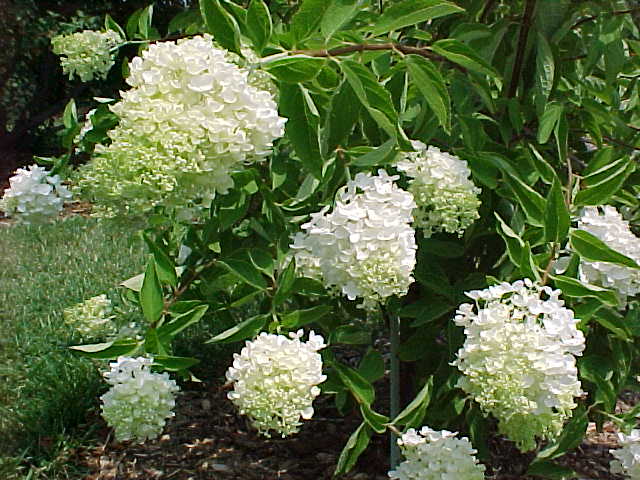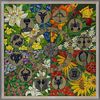Flower EncyclopediaENTER THE WORLD OF FLOWERS |
Other News
Hydrangea
Category: Perennial herbaceous plants
06 Oct : 14:02
To view pictures click on them







 This magnificently flowering plant of the family Kamenolomkovi (Saxifragaceae) is most often from the garden-glezhda, but it can at home.
This magnificently flowering plant of the family Kamenolomkovi (Saxifragaceae) is most often from the garden-glezhda, but it can at home.
Hydrangea (Hydrangea) belongs to the family of kamenolomkite (Saxifragaceae).
Hydrangea are deciduous, edrolistni, ornamental bushes and lianas, rarely - small trees. She holds numerous flowers, gathered in large clusters topkovidni colored in different bright colors: pink, red, white and even blue. One of the advantages of beautiful flowers is that they are generally mnogotrayni.
Konosovidni forming tufts of height 1.20 - 1.80 cm and width - 1.80 - 2,40 cm
The leaves are dark green, like the oak. They, and colors, changing their color through the seasons. In the autumn are silver or purple.
In - the old stems to peel the bottom in winter and appears dark brown bark. They are Japanese flowers and their kind are around 80.
Some species:
The most common types of hydrangea are 12, with a white face with small flowers and a tree hydrangea (H. arborescens). This is a North American shrub, often high, uniform two three meters. Its leaves are large (up to 20 cm), oval, bright green above and bluish-gray underneath. In our in cold regions premrazva sometimes, but with the advent of spring is quickly restored, and then profuse blooms. In the warmer areas may suffer from a lack of moisture.
Edrolistnata hydrangea (H. macrophylla) is a native of East Asia (China and Japan). It belongs to a number of the most common garden plants in the world. Relate to rapidly growing species, taking in their homeland reached a height of 4m. But moving to the north reduced in size to 1,2 m Solid bright green shiny leaves plenty thick bush cover. Large (up to 20cm.) Thick, topkovidni petals usually pink to slightly alkaline soil, and the sour - blue sky. Paucity and white. There are many forms and also hybrid hydrangea with pointed petals.
Earlier, thought this plant can grow only in warm corners, but with the efforts of amateur enthusiasts, and it reaches the northern places must be covered in winter. This type is suitable for growing in pots. If you bought this hydrangea for your garden do not be afraid of it planted in the ground.
Acid soils for her to prepare the land by bringing swampy place. It is desirable to periodically nourish the bush. But autumn has once again put it in the pot before the first snap to import it on the terrace or in the room, and from November to keep him in the basement at 5.6? C and moistening them rarely. The leaves fall - hydrangea 'rest.
In February, place them on the window and start spraying and watering them. In May you will get large clusters and may re-plant them in soil. Plant transplanting well tolerated during flowering, with a natural tussock land. And do not forget to watering the soul.
Heteromala hydrangea (H. heteromalla, H. bretschneideri). In his homeland, north China, grew up to 3m. And in our gardens usually reaches from 0,5 to 2m. Very original clusters (10-15 centimeters.) Which are completely green "platforms" such as snow-white butterflies. Later, their wings are pink or purple. Leaves (up to 12 cm.) Are ovoid and dark green. Naturally this kind is not appealing to gardeners as well as others, but lovers of fine play with nature so highly appreciated. This hydrangea is the most dry and frost-resistant among their sisters. Bloom in August and ends going to fall completely over-ground part declining, it is under snow in winter and spring shrubs recover quickly. In the dry summer watering needs.
Another interesting species from Japan, China and South Sakhalin, where there is often a kind of tree of 10 m high. is Metlovidnata hydrangea (H.paniculata). In our conditions, this large shrub grows from 2 to 5m. Opashatata is interesting hydrangea hydrangea or Laze (H.petiolaris, H scandens). It is a liana, which rises in trunks of trees to a height of 25 meters. With rare, white, pink or white inflorescences. Thanks to the many aerial roots liana is held for the bark of trees, walls and pillars. Without support it stele on the ground.
In our parks and gardens than those listed species may be encountered and Trionovidnata (H.serrata), prickly (H.aspera), Dabovidnata (H.quecifolia) hydrangea, and their various forms.
Colors ranging from red, pink and white to various shades of violet and blue. Numerous varieties of hydrangea differ in size and in shape. However, they all have some common features in keeping with who you know.
Flowering period:
June and July. Specimens that bloom from March to May have been previously raised by specialists.
Location:
It grows best in a shady spot or polusenchesto. To develop clusters in all their splendor of hydrangea it needs more space.
Light:
This flower does not like direct sunlight .. It bears a strong sun to partial shade. If the plant during the summer is cooler, the color will last longer fresh.
Soil:
Most - well grow into a rich, medium wet, well drained soil is. Acidity and should have a pH 6.5 - 4.5.
Fertilizing:
After July, during flowering, the flower is recommended to be dressed regularly.
Irrigation:
From March to late August is watered thoroughly and then less. Water softens, hydrangea does not tolerate much calcium. To August in the water for irrigation is added to the rhododendron fertilizer. In hot days, it is advisable to water spray and leaves her because otherwise they become dry and fall. Very important for hydrangea is to keep the roots moist in. This is especially true for shrubs planted around the trees.
Pests, Diseases:
Chlorosis due to hard water. Aphids, mites.
Hibernation:
The light or dark at 4-8 ¬į C. Hydrangea shed their leaves. Dried leaves are removed so as not to constitute an outbreak of diseases. Pour a little, but not tuff dries completely. In spring transplant and placed on a light.
Planting and propagation:
Hydrangea multiply by top cuttings, which are allowed to root in a cup of water. For better development of water can be added a little wood ash. Cuttings are taken in summer from the top of the shoot, which have no petals and are 2 to 4 leaves completely broken down. Hydrangea is a perennial plant. In bed stecklings be planted in at least 50 centimeters from each other. They quickly extended a few years formed a wide band of leaves, covered with numerous inflorescences.
Other tips:
Brashnyanata mildew (caused by fungi) appears at the bottom of the list. There are gray. The leaves are brown spots form. The colors are subsequently deformed. To eliminate this problem, you need to improve air circulation in the room. Often stems of the plant to swell and split. The leaves fall off. To remedy this problem, the plant must be thoroughly cleaned and washed, and replanted in new soil. The cause is worms. At very high levels of sodium and calcium in the soil, the leaves turn yellow. The color of hydrangea depends on the level of acidity of the soil. When the Ph level is low, the colors are blue. In neutral soil tsetovete are pink.
Hydrangea is extremely diverse. Set in the old stone vessels, it vazdeystvuva of English aristocratic, in the rustic oak bucket.
Influence of hydrangea:
Influence of atmospheric hydrangea home
In appearance and character of the hydrangea are joined manners air Libra Venus and Earth. The plant looks like a real husky, decorated with large flowers - that's clear manifestation of the earth's Venus, as stated on their needs: land - dry, thirsty for a verse about hydrangea requires copious watering. On it is also necessary coolness. It is now the "voice" of air Libra. Love the humidity and coolness to talk about emotional, yet lightweight nature, which gives the ability to hydrangea clears the space around her energy from heavy emotions and feelings: envy, jealousy, contempt and petulance. Desensitizing effect of hydrangea proved useful for every household, because no one person is not insured by the bad mood.
Impact of Health
Thanks to strong ground Venus - the planet of beauty and sensual pleasures - hydrangea enables one to make her beautiful body. If in any house plant, household refuse will be easier than sweet and fatty foods, from pasta
Effects of emotional state
Earth air hydrangea proved quite useful for those who "float in the clouds" do not have a practical streak, many, but not effectively be vanity, and for those who are standing firmly on the ground, not raised above head. Hydrangea tempered man in the earth practicality and air dreams.
| pointed petals amateur enthusiasts alkaline soil japanese flowers thick bush |
Comments are turned off for this item0
| pointed petals amateur enthusiasts alkaline soil japanese flowers thick bush |























































